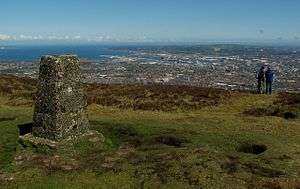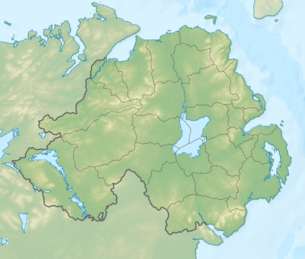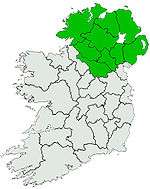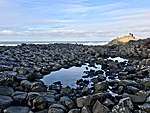Black Mountain (Belfast)
Black Mountain is a large hill which overlooks the city of Belfast, Northern Ireland.
| Black Mountain | |
|---|---|
| Sliabh Dubh/an Cnoc Dubh | |
 Triangulation pillar on Black Mountain | |
| Highest point | |
| Elevation | 1,275 ft (389 m) |
| Coordinates | 54°36′N 5°59′W |
| Geography | |
 Location in Northern Ireland | |
| Location | overlooking Belfast, Northern Ireland |
| OSI/OSNI grid | J266741 |
| Topo map | OSNI Discoverer 15 |
| Geology | |
| Mountain type | basalt |
The mountain is one of the most prominent features of the city, towering above most of west Belfast. It reaches a height of 1,275 ft[1] and is composed of basalt with limestone underneath,[2] as is Cavehill further north. There have been flint finds in the area, which also contains raths, deserted farms and overgrown paths joining the fields and homesteads and trails scattered over the mountain.[3] On a clear day there are views of Strangford Lough, the Mournes and the Sperrins, as well as Scotland and Donegal.[4]
Its name is probably derived from the adjoining mountain called Divis (/ˈdɪvɪs/; from Irish Dubhais, meaning 'black back').
There is a well-known field located on the Black Mountain, this is called the 'Hatchet Field', it is so called because it is in the shape of an old-fashioned hatchet. Also located on top of the mountain (Wolfe Hill) is a police barracks belonging to the Police Service of Northern Ireland and the Black Mountain transmitting station which is a broadcasting and telecommunications facility. One way to proceed up the mountain is by the 'Mountain Loney,' a path leading up the mountain and across the 'Hatchet Field'. This path is found adjacent to Dermot Hill, a housing estate in west Belfast, and is popular with walkers and tourists.
For many years people have lobbied for the preservation of the Belfast Hills, hoping to bring an end to many years of quarrying.[5] The quarry is steep and deeply excavated and the basalt from it is used mostly for road stone.[2]
See also
Awards
- Amazing Spaces award (8 November 2005)[6]
References
- Walk NI, Divis & Black Mountain Archived December 19, 2011, at the Wayback Machine
- Black Mountain Quarry, Belfast, Habitas, Earth Science Conservation Review, National Museums Northern Ireland
- Belfast Hills Archived May 23, 2007, at the Wayback Machine
- NITB
- "Northern Ireland Assembly Monday 30 April 2001 (continued) Conservation on the Black Mountain". Northern Ireland Assembly. 2001-04-30. Archived from the original on 2011-04-24. Retrieved 2016-02-18.
Every year 500,000 tonnes of stone are removed from the Black Mountain. Two thousand five hundred tonnes are removed every day.
- Latest News:: Divis & Black Mountains win Award :: Belfast's Official Tourism Website - Gotobelfast.com Archived December 31, 2005, at the Wayback Machine
External links
- Virtual tour of Black Mountain - Virtual Visit Northern Ireland


